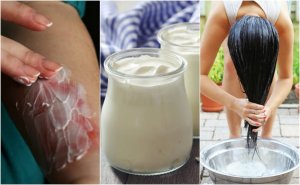6 Ways to Use Natural Yogurt in Homemade Remedies

These healthy bacteria repopulate the gut flora while strengthening the immune system, preventing infections and illnesses. Additionally, yogurt’s usefulness makes it a handy ingredient in many everyday dishes and drinks.
Most people don’t know yogurt isn’t just a food. It can be used as a base for homemade remedies to treat a variety of problems. Even though, it may not give magical results, its unique composition can improve certain external symptoms.
Below are the 6 best uses for yogurt people may not know about.
Take note of the following!
1. Soothe burns

Yogurt’s lactic acid helps regulate pH in the skin, speeding up the regeneration process in minor burns. Applying yogurt directly on burns creates a refreshing sensation, it reduces the burning and redness.
Method
- Let yogurt cool in the refrigerator. Afterwards, gently massage it into the affected area.
- Let it sit for 15 minutes and carefully wipe away the excess with a wet cloth.
- Repeat 2 times a day until the skin has completely healed.
Also read: Treat Sunburns with These 5 Natural Remedies
2. Treat nail fungus
Yogurt’s active cultures are helpful for treating nail fungus infections. It’s anti-fungal properties help stop these microorganisms from growing. Also, it’s whitening affect reduces the yellowish appearance.
Method
- Massage a small amount of yogurt into the affected nails.
- Let it to dry for 30 minutes then wash off with warm water.
- Use it at least 3 days a week, twice each day.
3. Reduce dandruff

Yogurt’s anti-fungal effect also works great against dandruff causing fungus. Its nutrients regulate pH and prevents dryness, it also reduces excessive sebum from building up.
Method
- Dampen hair, separate into sections and apply yogurt throughout the entire scalp.
- Let it sit for 30 minutes then wash off.
- Use it 3 times a week.
4. Treat canker sores
The healthy bacteria found in natural yogurt can help fight the microorganisms that produce canker sores. Using yogurt as a remedy re-balances the skin’s pH and helps the healing process.
Method
- Rub a little bit of cold yogurt on the sores.
- Let is sit and apply 2 or 3 times a day.
- Keep using the treatment until the sores disappear.
Also see: Treat and Prevent Canker Sores
5. Whiten teeth

Using yogurt on your teeth is not as efficient as professional products. However, using yogurt daily can reduce the appearance of those bothersome yellowish stains that come from food residue. Yogurt’s acids help remove plaque that harm enamel. Thus, it reduces the risk of infections.
Method
- Put a little yogurt on your toothbrush and brush normally.
- Let it sit without rinsing, use it twice a day.
Note: Yogurt shouldn’t replace brushing with toothpaste. Brush your teeth with yogurt after using mouthwash.
6. Combat acne
The acidic and antioxidant compounds found in natural yogurt help stop excessive oil production on the face and it reduces acne. Yogurt’s exfoliating effect removes impurities building up in pores. Likewise, yogurt oxygenates the skin, leaving it fresh and hydrated.
Method
- Spread natural yogurt throughout your face or any area that’s prone to acne.
- Let it sit 30 minutes. Once it’s dry, wash off with warm water.
- Use it 3 or 4 times a week.
Did you know about these alternative uses for natural yogurt? As you can see, it is more than just a food. Yogurt is a multi-use ingredient used to help treat common problems.
It doesn’t have any side-effects and you can use it whenever you want.
All cited sources were thoroughly reviewed by our team to ensure their quality, reliability, currency, and validity. The bibliography of this article was considered reliable and of academic or scientific accuracy.
- Hussain, I., Attiq-ur-Rahman, & Atkinson, N. (2009). Quality comparison of probiotic and natural yogurt. Pakistan Journal of Nutrition. https://doi.org/10.3923/pjn.2009.9.12
- Nishihira, J., Kagami-Katsuyama, H., Tanaka, A., Nishimura, M., Kobayashi, T., & Kawasaki, Y. (2014). Elevation of natural killer cell activity and alleviation of mental stress by the consumption of yogurt containing Lactobacillus gasseri SBT2055 and Bifidobacterium longum SBT2928 in a double-blind, placebo-controlled clinical trial. Journal of Functional Foods. https://doi.org/10.1016/j.jff.2014.09.002
- Caleja, C., Barros, L., Antonio, A. L., Carocho, M., Oliveira, M. B. P. P., & Ferreira, I. C. F. R. (2016). Fortification of yogurts with different antioxidant preservatives: A comparative study between natural and synthetic additives. Food Chemistry. https://doi.org/10.1016/j.foodchem.2016.04.114
This text is provided for informational purposes only and does not replace consultation with a professional. If in doubt, consult your specialist.








